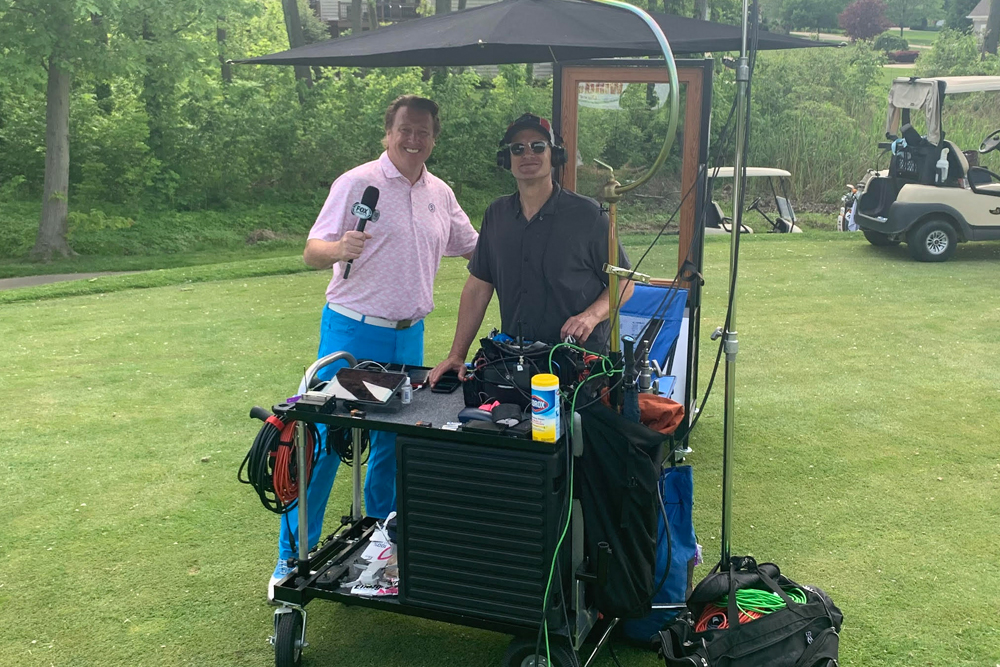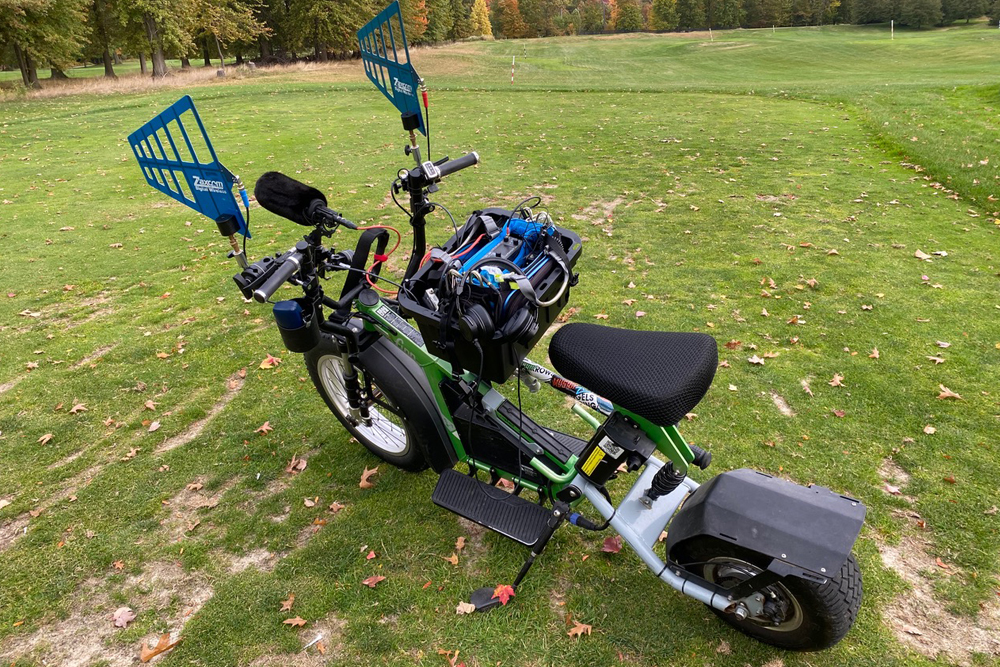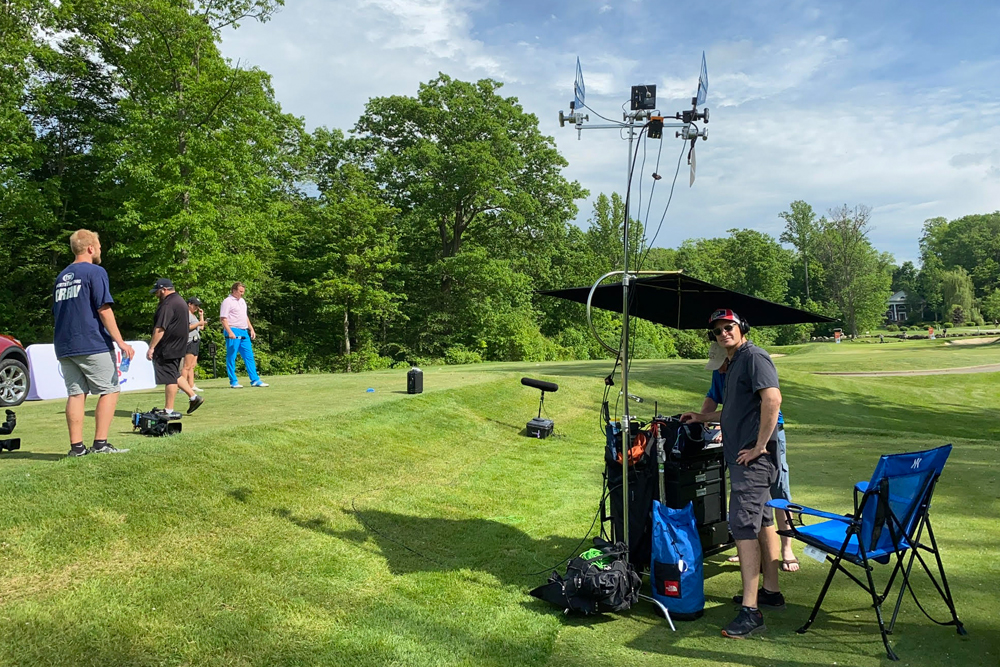
Noel Dannemiller is an Ohio based production sound mixer who has traveled the world recording audio for television, commercials, and films, including the Emmy winning series The Amazing Race. He got his start as a crew member on music tours eventually earning enough to buy his first sound package in 1996. For those curious it was a Cooper CS104, boom pole, one wireless radio, and he recorded on a Nagra. Keeping roots in The Buckeye State, Dannemiller made a name for himself in the sports world being tapped regularly for NFL, college, and NBA finals games. One of his longest working relationships is with PGA golf pro Jimmy Hanlin who over the years has created a number of golf-related shows Dannemiller has been fortunate to mix from the beginning.
Hanlin’s programs include the humorously entertaining interview series Links to the Game, the golf tip show Swing Clinic, the golfer’s tour guide series Blaster’s 18 Holes, and Pin Shot, a high-stakes challenge series where players attempt to land on the green in a single swing. The latter of which Dannemiller says is “really proud of because they built it up from nothing.” The early days of Pin Shot saw Dannemiller recording episodes using hardline. “I was running a lot of cables to get receivers closer because I didn’t have the infrastructure. But over time, the show grew along with the budget and so did my infrastructure. Now I can set up on the tee box with all my gear and shoot straight down the hole getting 200 yards of coverage,” he says.
The sound mixer credits his new workflow to Zaxcom which centers on the Nova mixer-recorder, Aria Control Surface, and Digital Recording Wireless that includes bodypack, boom, and handheld transmitters as well as receivers. He has even customized a motorized bike to rig his gear and stay mobile. Below, Dannemiller talks about his college hurdles, touring with The Ramones, and how mixing where he grew up has created a fulfilling career and an enjoyable life.
Have you always been Ohio based?
Yes. I live in the same neighborhood I grew up in. It’s just home. It always felt right. I have been fortunate to travel the world a couple of times over, but I still live where I want to live. The coast is great to visit, but this is home.
What got you interested in sound?
I was a musician growing up playing in an orchestra and loved music. I always thought I wanted to own a recording studio and record bands. So, I went to Ohio State University to major in audio recording and work towards owning my own recording studio.

How was attending The Ohio State?
The college actually shut down the audio recording program during my second quarter so I gravitated towards the film program specializing in sound thinking that was a good compliment. Then Ohio State got rid of that program too.
Oh wow. Did you switch programs again?
I ended up creating my own major at college. It was a personalized study program that allowed me to come up with all the aspects of a major they don’t offer and combine them into a degree. Getting people in different departments to sign off and approve it was the hardest part.
Did you jump into music recording or production sound after college?
One day, my sister invited me to a high-end regional commercial set. There, I saw a sound guy doing sound, and that was my first taste of location sound. I figured out I didn’t want to spend my days in the studio but out in the field, where everywhere is your studio. Afterward, I started gripping for commercials and slowly transitioned into sound on location.
What gigs got you going as a sound mixer?
I started out doing television and corporate work. Then I spent three years touring with Tony Bennett, Johnny Mathis, The Ramones, and Boyz II Men. I was mostly a flying PA, did some stage patching, and then would mix opening acts for people who didn’t carry their own sound mixer. Then after too many tours, I got back to TV and have been doing it ever since.
How did you come to meet Jimmy Hanlin, the creator and host of Pin Shot?
Through a camera operator named Bryan Frania. He’s been working with Jimmy forever. Jimmy is really awesome and a hustler. He’s grown this TV program just being a pro golfer. When Tiger Woods came on the scene, one of the radio stations needed a golf pro to talk about him. Jimmy went on and did really well, and they kept inviting him back. He eventually started creating his own shows and finding sponsors. Right now, he has four different shows going and I’ve probably been with him for 9 or so years now.
What’s your primary gear set up for Pin Shot?
In the early days, I was running a lot of cables to get receivers close enough because I didn’t have the right infrastructure to support the show. Over time, it grew, and I am now covering 200 yards of golf course wirelessly, thanks to Zaxcom. My primary mixer is the Nova, and I’ve been using it since it came out. I use all 8 channels of built-in wireless and pair it with the Aria Control Surface.
How do you set up audio for an episode of Pin Shot?
We run four cameras and have two hosts. One host is on the tee box with an Audio Technica BP4001 mic capsule connected to a Zaxcom ZMT3-HH transmitter. The host is also lav’d with a Sanken COS-11D and a Zaxcom TRX3LA transmitter. During the show, they’re responsible for interviewing the contestant before hitting the shot. I also place a Sanken CS-3e shotgun with a Zaxcom ZMT3-Phantom in the tee box area for ball strike and crowd reaction.
On the green is our second host, offering the play-by-play of the ball flight and where it lands. I pair another Audio Technica BP4001 mic with Zaxcom ZMT3-HH transmitter and place an Audio Technica BP4027 stereo shotgun with a Zaxcom TRX743 transmitter to capture the environment.

How do you approach the mix?
All the talent are on ISO tracks, and I am sending a stereo mix to the cameras. I do mix it live, which the editor appreciates. Jimmy breaks the fourth wall and lets the camera guys be part of the show and provide entertainment. So, when Jimmy is interviewing someone having him lav’d the whole time allows me to not worry about him. Then I have a boom on a stand that’s above them getting the ball strikes and the crowd behind them gets picked up a little.
Are you running communication between the hosts?
Yes. I have two Comtek channels with earpieces. This helps the host banter back and forth.
You mentioned four cameras. Do you feed them audio as well?
We do. I use a Zaxcom TRX900 with a STA150 camera link with two QRX200 receivers. The camera operators monitor audio via Zaxcom ERX3TCD. Everything is jam-synced using the Zaxcom ERX3TCD.

Since you’re covering 200 yards or more, are you using larger antennas?
Yes. I always use Shark fin-style antennas. I typically put two shark fins on the front of the golf cart that I use. My sound bag sits on the side of me, and I drive around in the cart. I generally stay in the cart unless there’s an audio issue. The crew will make fun of me for staying in there all day, but it’s a good thing because we don’t have any problems. No one wants to hear from the sound guy.
What was your process for finding your maximum wireless range?
As I mentioned, I built my golf cart as my studio. I would test different places, trying halfway down the fairway and then a little bit more each time until I was at the entire hole range. It took some time to figure out and to have the right gear, antennas, and antenna cables to get to the point where I am now. I’m never not nervous going into a new location, but I am pretty confident each time I show up that I will be able to cover it wirelessly, and the two hosts will be able to communicate being so far apart.
Are you using the internal recording feature on the Zaxcom transmitters or perhaps ZaxNet?
What I love most about Zaxcom wireless is that the only thing I physically do is place the wire on the talent and change the battery. Everything else I do on my mixer. I set the gain and tell them to record or stop. If I have a frequency problem, I go into the Nova and change it. Once I place the transmitter on the talent, I never have to go up to them and mess with it. Also, everything is recorded on the internal microSD cards of each transmitter. It’s great to have if I ever do have a dropout.
Do you use any of the advanced features on Nova for your mix?
I rarely use Rerecord and I’ll see NeverClip when it gets engaged, but it’s not often. I do always have PreRecord on because you never know. I’m using about 75% of what the Nova is capable of doing and it does everything well and I never have had any problems.

You also work on Links to the Game. Any hurdles on that show?
On that show we pair 4 athletes or sports figures together, and with Jimmy, that makes 5 people on camera. They play golf and tell stories about being a pro athlete or games. We did the Columbus Blue Jackets hockey team, and we had 3 players, 1 broadcaster of the team, and Jimmy. At any point, there can be two different conversations going on anywhere on the golf course, and I am the only sound person covering it. So I lock my transmitters into record all day, that way I am not in range, I know that I have it. It’s a fly-by-the-seat-of-your-pants kind of show where you never know when someone is going to say something or where they are going to say it. It can get chaotic, but it all comes together.
Any advice for sound mixers starting out in Ohio?
The way I did it back then was I kept bugging people so much that they got sick of hearing from me, and they finally booked me. I kept calling them every week or sending them an email. It’s just perseverance. Build relationships with camera guys too. They have more reach in terms of production inside and outside the state.
You can follow Noel on Instagram where he posts cool boom shots of the day.